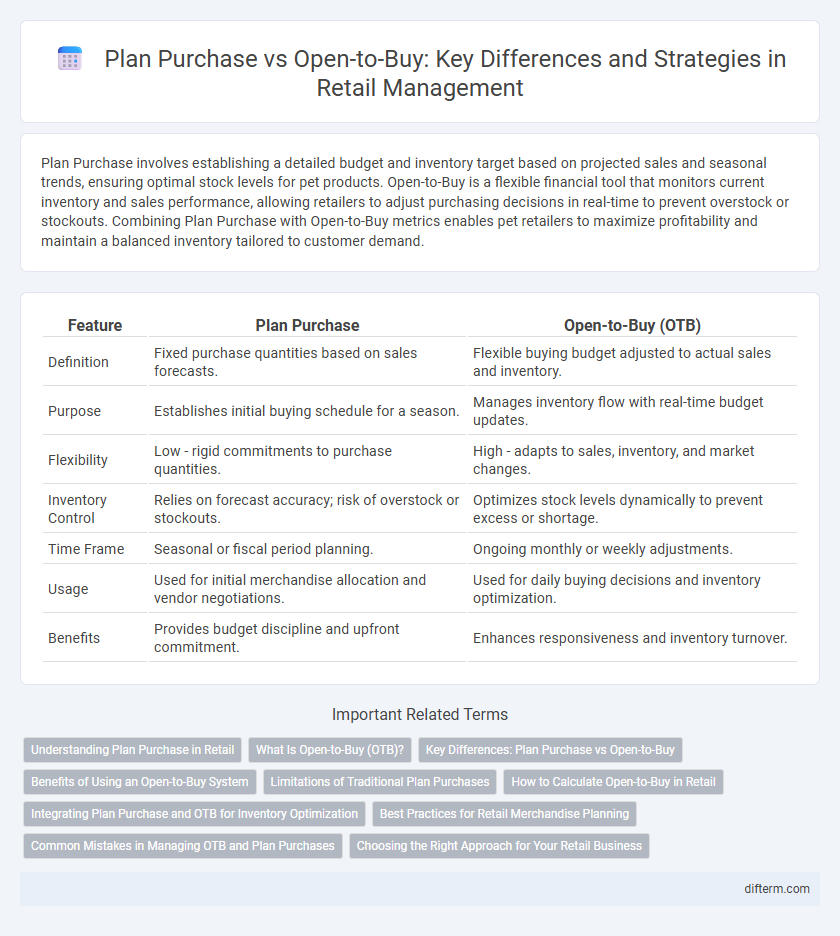Plan Purchase involves establishing a detailed budget and inventory target based on projected sales and seasonal trends, ensuring optimal stock levels for pet products. Open-to-Buy is a flexible financial tool that monitors current inventory and sales performance, allowing retailers to adjust purchasing decisions in real-time to prevent overstock or stockouts. Combining Plan Purchase with Open-to-Buy metrics enables pet retailers to maximize profitability and maintain a balanced inventory tailored to customer demand.
Table of Comparison
| Feature | Plan Purchase | Open-to-Buy (OTB) |
|---|---|---|
| Definition | Fixed purchase quantities based on sales forecasts. | Flexible buying budget adjusted to actual sales and inventory. |
| Purpose | Establishes initial buying schedule for a season. | Manages inventory flow with real-time budget updates. |
| Flexibility | Low - rigid commitments to purchase quantities. | High - adapts to sales, inventory, and market changes. |
| Inventory Control | Relies on forecast accuracy; risk of overstock or stockouts. | Optimizes stock levels dynamically to prevent excess or shortage. |
| Time Frame | Seasonal or fiscal period planning. | Ongoing monthly or weekly adjustments. |
| Usage | Used for initial merchandise allocation and vendor negotiations. | Used for daily buying decisions and inventory optimization. |
| Benefits | Provides budget discipline and upfront commitment. | Enhances responsiveness and inventory turnover. |
Understanding Plan Purchase in Retail
Plan Purchase in retail refers to a strategic budgeting process that forecasts the amount of inventory a retailer intends to buy for a specific period. It aligns merchandise buying with sales goals and seasonal demand, helping retailers maintain optimal stock levels while minimizing overstock and stockouts. This approach contrasts with Open-to-Buy, which is a more dynamic, real-time financial control tool used to manage actual inventory purchases against planned budgets.
What Is Open-to-Buy (OTB)?
Open-to-Buy (OTB) is a financial budget management tool used in retail to control the amount of inventory purchased within a specific period, ensuring alignment with sales forecasts and planned stock levels. It represents the dollar amount available for buying new merchandise after accounting for current inventory and committed purchase orders. Utilizing OTB helps retailers optimize inventory turnover, reduce stockouts, and maintain balanced cash flow.
Key Differences: Plan Purchase vs Open-to-Buy
Plan Purchase represents the total forecasted inventory commitments based on seasonal sales projections and promotional strategies, serving as a long-term purchasing roadmap. Open-to-Buy (OTB) reflects the available budget remaining for inventory procurement within a specific period, ensuring that stock levels align with sales velocity and cash flow constraints. The key difference lies in Plan Purchase guiding overall inventory goals, while Open-to-Buy manages real-time purchasing flexibility and prevents overstock or stockouts.
Benefits of Using an Open-to-Buy System
An open-to-buy (OTB) system provides precise inventory control, helping retailers align purchases with sales trends to optimize stock levels and reduce overstock or stockouts. Real-time budget monitoring through OTB improves cash flow management by allowing dynamic adjustments based on current sales performance. This system enhances decision-making accuracy by integrating sales data, planned promotions, and seasonal fluctuations, leading to increased profitability and customer satisfaction.
Limitations of Traditional Plan Purchases
Traditional plan purchases often struggle with inflexibility, as they rely heavily on historical sales data that may not account for real-time market trends or sudden demand shifts. These plans can lead to overstocking or stockouts, causing losses in revenue and customer satisfaction. The lack of integration with dynamic inventory systems limits the ability to adapt quickly to consumer behavior changes in retail environments.
How to Calculate Open-to-Buy in Retail
To calculate Open-to-Buy (OTB) in retail, subtract current inventory and planned purchases from the planned sales for a specific period. Use the formula: OTB = Planned Sales + Planned Markdowns - Current Inventory - Planned Purchases. This calculation helps retailers maintain optimal stock levels, avoid overbuying, and ensure sufficient inventory to meet sales goals.
Integrating Plan Purchase and OTB for Inventory Optimization
Integrating Plan Purchase and Open-to-Buy (OTB) systems enhances inventory optimization by aligning planned merchandise budgets with real-time sales and stock levels. This synchronization enables retailers to adjust purchasing decisions dynamically, reducing overstocks and stockouts while maximizing sales opportunities. Leveraging data analytics within both Plan Purchase and OTB frameworks ensures inventory investments are precisely targeted to consumer demand and seasonal trends.
Best Practices for Retail Merchandise Planning
Effective retail merchandise planning hinges on aligning Plan Purchase with Open-to-Buy (OTB) to optimize inventory levels and maximize sales potential. Regularly comparing Plan Purchase forecasts with OTB budgets helps identify discrepancies early, ensuring financial discipline while meeting market demand. Leveraging accurate sales data and historical trends refines purchase decisions, preventing overstock and stockouts through strategic inventory control.
Common Mistakes in Managing OTB and Plan Purchases
Common mistakes in managing Open-to-Buy (OTB) and plan purchases include inaccurate demand forecasting, leading to overstock or stockouts that hinder cash flow and sales performance. Retailers often fail to regularly update OTB plans based on real-time sales data, resulting in misaligned inventory levels and reduced profitability. Ignoring supplier lead times and promotional calendars during purchase planning further disrupts inventory balance and customer satisfaction.
Choosing the Right Approach for Your Retail Business
Plan Purchase emphasizes forecasting sales and inventory needs based on historical data and seasonal trends, ensuring alignment with business goals and customer demand. Open-to-Buy (OTB) offers real-time budget control, enabling retailers to manage inventory levels dynamically and respond to market fluctuations. Selecting between these methods depends on your retail operation's size, data availability, and the need for flexibility versus strategic planning.
Plan Purchase vs Open-to-Buy Infographic

 difterm.com
difterm.com